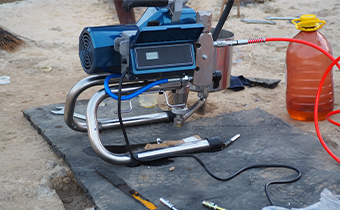Grouting Works
Grouting is the process of injecting materials into cavities or cracks in concrete, masonry structures, rock-mass, subsurface soil, or rock to increase the structure’s load-bearing capacity, and the material used for this objective is called grout.
It is the specifically prepared cement under pressure to form a stable suspension or liquid into pores, fissures or voids, or cement mixtures at a high flow rate to increase strength. While grout is normally a combination of cement, sand, and water or chemical substances which can be used to fill gaps.

”The grout is the mixture of paste that contains cement, sand, chemical and a certain quantity of water which can be injected to seal the cracks or pothole. The grout is used to seal the crack and used in tile flooring work to fill the gap between the tiles, filling the gaps for waterproofing and soil stabilization. There are different types of grouting, cement grouting, chemical grouting, and bituminous grating, depending on the material used. Resins are also sometimes used as grout materials. Hot Bitumen Grouting is a special type of grouting where melted bitumen is used as grouting material.“
Advantages of Grouting
- This may be achieved on virtually any floor situation.
- It does not induce vibration and it may be controlled to avoid structural damage.
- Improvements in ground structures can be measured.
- It is very useful for limited space and low headroom applications.
- The slab is used for jacking that elevates or flattens the deformed foundation.
- It can be installed adjacent to existing walls.
- It can be used to control the seepage, groundwater flow and hazardous waste materials.
